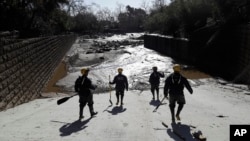Hundreds of rescue workers slogged through knee-deep ooze and used long poles to probe for bodies Thursday as the search dragged on for victims of the mudslides that slammed this wealthy coastal town. Seventeen people were confirmed dead and eight others were missing.
Family members anxiously awaited word on loved ones who hadn't been heard from since the onslaught early Tuesday.
"It's just waiting and not knowing, and the more I haven't heard from them — we have to find them," said Kelly Weimer, whose elderly parents' home was wrecked. The couple, Jim and Alice Mitchell, did not heed a voluntary evacuation warning and stayed home to celebrate Jim Mitchell's 89th birthday.
Santa Barbara County authorities sent a shudder through the community early Thursday when they reported that the number of people unaccounted for had surged from 16 to 48. But later in the morning, they said they had made a clerical error, and the actual number of missing was down to eight.
As search dogs clambered on heaps of wood that used to be homes, mud-spattered rescue teams from all over California worked their way through the ruins of Montecito, an enclave of 9,000 people northwest of Los Angeles that is home to celebrities such as Oprah Winfrey.
It was left covered with thick muck, boulders, wrecked cars, splintered lumber and tree limbs in a scene Santa Barbara County Sheriff Bill Brown likened to a World War I battlefield.
Downtown, a quaint stretch of cafes and galleries normally bustling with tourists and locals was a staging area for fire trucks and heavy equipment Thursday. Fire and sheriff's officials hovered over a map spread across the hood of a truck while a fire crew made up of inmates loaded trucks for another day of debris removal.
On the edge of the disaster zone, John Flynn looked dazed as he stood in the driveway of his home. Fallen power lines crisscrossed a neighbor's yard, trees lay like bowling pins, and the air smelled of wet ash and sewage.
"We came through OK. We are the lucky ones," he said, shaking his head with the knowledge that one stray boulder on a different trajectory could have taken out his hillside home. Down the block, just the crushed roof of a home stuck out of a sea of dark brown mud.
After a better look at the damage, officials lowered the number of destroyed homes from 100 to 64 and raised the number of damaged ones from 300 to 446.
Overall, 28 people were injured. Twelve remained hospitalized, four in critical condition.
By Wednesday, some 500 searchers had covered about 75 percent of the inundated area, authorities said. They had a long slog ahead, filled with hazards seen and unseen.
"A lot of the street signs are gone, the roads are impassable. It all has to be done on foot," said Deputy Dan Page, chief of a Los Angeles County Sheriff's Department rescue team.
Rescue crews worked up to 12 hours a day and risked stepping on nails or shattered glass, or being exposed to raw sewage, or dealing with leaking gas, Page said.
"We've gotten multiple reports of rescuers falling through manholes that were covered with mud, swimming pools that were covered up with mud," said Anthony Buzzerio, a Los Angeles County fire battalion chief. "The mud is acting like a candy shell on ice cream. It's crusty on top but soft underneath, so we're having to be very careful."
Crews marked where bodies were found, often far away from a home, and used that information to guess where other victims might have ended up as the surging mud carried or buried them.
People in Montecito had counted themselves lucky last month after the biggest wildfire in California history spared the town. But it was the fire that led to the mudslide, by burning away vegetation.
"We totally thought we were out of the woods," said Jennifer Markham, whose home escaped damage in both disasters. "I was frozen yesterday morning thinking, `This is a million times worse than that fire ever was."'
The mudslides were already occurring when Santa Barbara County officials first sent emergency alerts to cellphones in the area, the Los Angeles Times reported Thursday.
For days, the county had issued repeated warnings via social media, news media and emails about the potential for mudslides. But county emergency manager Jeff Gater said officials decided not to use the cellphone push alert system until 3:50 a.m. Tuesday out of concern it might not be taken seriously.
Only an estimated 10 to 15 percent of residents fled when ordered, and much of the damage occurred where evacuations were voluntary.
It could take days or even longer before the work is finished.
"That's always our mentality: `Hey, we're going to find someone alive,"' Page said. "You never really know. You never know exactly what the human body is capable of."
In 2014, a mudslide in rural Oso in Washington state killed 43 people. The last body was found four months later.
Associated Press writers Amanda Lee Myers, Robert Jablon, John Antczak, Michael Balsamo, Frank Baker, Brian Melley and Andrew Dalton in Los Angeles, Alina Hartounian in Phoenix, and Aron Ranen in Montecito contributed to this report.
This story has been corrected to show that the official number of missing is eight, not 48 as previously reported by Santa Barbara County officials. They blamed a clerical error for the incorrect count.







